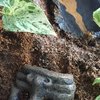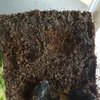So, I am brand new to this hobby and am just about to make my foray into scorpions. I was thinking about Heterometrus spinifer, based on suggestions I have seen on this forum.
Because I am brand new to this, I set up the tank in stages so I could watch it and keep an eye on temperature and humidity before I brought an animal home. I do not presently have any critters - I am pleased with that decision.
The primary question is this: I noticed the other day that there was a pale grayish fuzz growing on top of the substrate in places - just places, not the whole tank, and only on top. I have attached pictures, where you'll see that it isn't covering the whole top, and didn't grow in the spot where I rested the analog gauge I was testing (I have a digital humidity/temperature gauge, but I also have analog gauges in there at the same time, because I wanted to see the difference. I have seen the difference, it is impressive.)
I assume this is mold (it has a dusty look) that is growing because the substrate was already moist when I put it in (I got it to the point that it didn't drip unless squeezed hard). I didn't add water to the false bottom yet, but there isn't a tremendous amount of ventilation where I put the tank (which is NOT going to sit next to the window, I put it there to see what the sun would do to the fuzz).
To run through what I've done:
I set up a glass 10 gallon terrarium with a false bottom (just a couple inches of larger aquarium gravel with a fill pipe on the side) under the Eco Earth expanding brick substrate. I picked up a small Pothos, washed its roots and leaves to get as much of the potting soil in those roots out as possible, and planted it in the substrate (it is doing quite well off the moisture just in the Eco Earth, in its shady corner). My apartment's ambient temperature this time of year is in the low to mid 70s, so I put a heating pad on one side of the tank (on the side, above the gravel line, not underneath) to give it a gradient, and was thinking about adding a heat lamp when things get cooler (my ambient winter temperatures are upper sixties/low seventies). For reference, the fuzz didn't grow on the substrate next to the heating pad. I have a water dish thing and a partially buried hide with the start of a burrow as well.
So, questions: Is this mold? Should I take the substrate out and bake new substrate before I put it back in? Is this type of mold not a big deal? What do you all recommend for disinfecting the tank without leaving too many chemicals (for those things I have that are plastic and can't go in the oven)?
Again, there are NO ANIMALS, scorpions or isopods, in this tank, because these are exactly the kind of kinks I wanted to work out before I accidentally killed something with a bad setup. It will not normally sit by the window, it will sit in a corner on the other side of a bookcase from the window, where the only light it will get will be room lighting and indirect light. I have included pictures of what I'm seeing.
Thanks all!
bro
Because I am brand new to this, I set up the tank in stages so I could watch it and keep an eye on temperature and humidity before I brought an animal home. I do not presently have any critters - I am pleased with that decision.
The primary question is this: I noticed the other day that there was a pale grayish fuzz growing on top of the substrate in places - just places, not the whole tank, and only on top. I have attached pictures, where you'll see that it isn't covering the whole top, and didn't grow in the spot where I rested the analog gauge I was testing (I have a digital humidity/temperature gauge, but I also have analog gauges in there at the same time, because I wanted to see the difference. I have seen the difference, it is impressive.)
I assume this is mold (it has a dusty look) that is growing because the substrate was already moist when I put it in (I got it to the point that it didn't drip unless squeezed hard). I didn't add water to the false bottom yet, but there isn't a tremendous amount of ventilation where I put the tank (which is NOT going to sit next to the window, I put it there to see what the sun would do to the fuzz).
To run through what I've done:
I set up a glass 10 gallon terrarium with a false bottom (just a couple inches of larger aquarium gravel with a fill pipe on the side) under the Eco Earth expanding brick substrate. I picked up a small Pothos, washed its roots and leaves to get as much of the potting soil in those roots out as possible, and planted it in the substrate (it is doing quite well off the moisture just in the Eco Earth, in its shady corner). My apartment's ambient temperature this time of year is in the low to mid 70s, so I put a heating pad on one side of the tank (on the side, above the gravel line, not underneath) to give it a gradient, and was thinking about adding a heat lamp when things get cooler (my ambient winter temperatures are upper sixties/low seventies). For reference, the fuzz didn't grow on the substrate next to the heating pad. I have a water dish thing and a partially buried hide with the start of a burrow as well.
So, questions: Is this mold? Should I take the substrate out and bake new substrate before I put it back in? Is this type of mold not a big deal? What do you all recommend for disinfecting the tank without leaving too many chemicals (for those things I have that are plastic and can't go in the oven)?
Again, there are NO ANIMALS, scorpions or isopods, in this tank, because these are exactly the kind of kinks I wanted to work out before I accidentally killed something with a bad setup. It will not normally sit by the window, it will sit in a corner on the other side of a bookcase from the window, where the only light it will get will be room lighting and indirect light. I have included pictures of what I'm seeing.
Thanks all!
bro

Attachments
-
860.6 KB Views: 10

